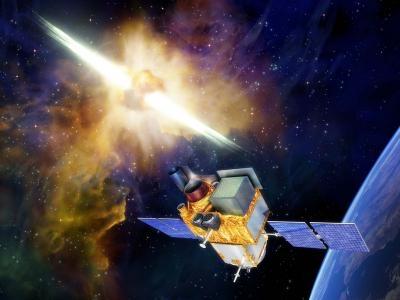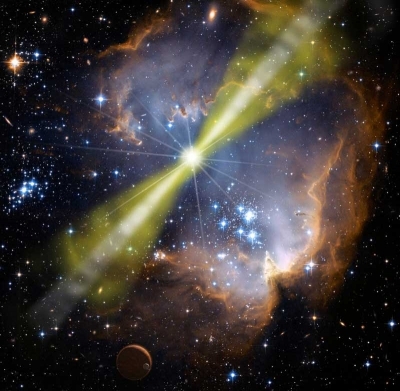Green light for the SVOM mission
The CNES Administration Board recently approved the French Space Agency’s commitment to the Sino-French scientific mission SVOM (Space-based Multiband Astronomical Variable Objects Monitor). The SVOM satellite will be launched in 2021 to scrutinize the gamma ray bursts. The CNES and the French research laboratories (CNRS, Universities and CEA) will provide key elements for this mission. In total, ten CNRS-INSU and CNRS-IN2P3 laboratories including the IRAP (Paul Sabatier University of Toulouse & CNRS) are involved in this project.

SVOM is a satellite dedicated to the study of gamma-ray bursts, those ultra-energetic bursts that reach us from all over the universe. These phenomena signal cataclysmic events, such as the final explosion of very massive stars, or the coalescence of neutron stars with each other or with black holes.
Although several hundred gamma-ray bursts have been detected to date, they remain imperfectly understood. Phenomena that are transient in nature – the longest can be observed for a few days, the shortest for a few minutes – studying them requires both state-of-the-art observing instruments and exceptional responsiveness from the satellite and the mission ground segment.

SVOM will provide the international scientific community with real-time celestial coordinates of the bursts it detects, so that complementary ground-based telescopes can be pointed as quickly as possible. The satellite will be able to reorient itself and all its instruments to these events in a matter of minutes. The SVOM system has been particularly optimised so that the bursts detected can be observed in detail by the ground-based telescopes. Its instruments have been designed to be sensitive to particularly distant bursts, known as cosmological bursts, whose study will open a window on the very young universe.
During SVOM’s mission, gravitational wave and neutrino detectors will also be in operation. The temporal coincidence between these observatories of transient cosmic phenomena promises to be so scientifically rich that agreements are already planned between the scientists concerned.
French research
Under the terms of the agreement with the Chinese space agency, CNSA, signed in August 2014, CNES will deliver two of the four scientific instruments carried by the satellite: the MXT X-ray telescope and the ECLAIRs wide-field X-ray and gamma-ray camera, which will detect bursts and trigger the fully automatic warning system. CNES must also provide the mission with a ground-based warning system based on a network of VHF antennas for real-time reception and dissemination of satellite messages, a ground-based system for programming French instruments and data processing, and a ground-based robotic telescope dedicated to the mission.
SVOM is an unprecedented technical and scientific cooperation between CNES and its French scientific partners, CNSA, CAS (Chinese Academy of Science), to which CNSA is delegating the realization of the satellite, and other Chinese institutes in charge of the ground segment of the mission.
The French contribution to SVOM will be developed in cooperation with ten scientific laboratories of the CNRS and CEA, as well as with the Max Planck Institute for Extraterrestrial Physics in Garching, Germany, and the National Autonomous University of Mexico.
The laboratories participating in the SVOM mission are the following:
- Astrophysics Instrumentation and Modeling (University Paris Diderot / CEA-IRFU / CNRS)
- AstroParticles and Cosmology (Université Paris Diderot / CNRS / CEA / Observatoire de Paris)
- Marseille Centre for Particle Physics (Aix-Marseille University / CNRS)
- Paris Institute of Astrophysics (Pierre and Marie Curie University / CNRS)
- Institute of Research in Astrophysics and Planetology (University Toulouse 3 – Paul Sabatier / CNRS)
- Linear Accelerator Laboratory (Université Paris Sud / CNRS)
- Marseille Astrophysics Laboratory (Aix-Marseille University / CNRS)
- Galaxies, Stars, Physics and Instrumentation Laboratory (Université Paris Diderot / CNRS / Observatoire de Paris)
- Laboratoire Univers et Particules de Montpellier (University of Montpellier / CNRS)
- Astronomical Observatory of Strasbourg (University of Strasbourg / CNRS)
Involvement of the IRAP in the SVOM mission
- Conception of two instruments : ECLAIRs and CAGIRE
- Plan of detection of the spatial instrument ECLAIRs
- Flight monitoring center of the ECLAIRs instrument
- CAGIRE infrared camera for the ground tracking of gamma ray bursts
- GFT Ground Telescope Control Software
- Several contributions to the scientific ground segment
Further Resources
- Website dedicated to the mission : https://svom.cnes.fr/
- Website dedicated to the scientific aspect of the mission : http://www.svom.fr/
IRAP Contact
- Jean-Luc Atteia, Jean-Luc.Atteia@irap.omp.eu






